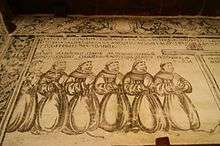Twelve Apostles of Mexico

The Twelve Apostles of Mexico, or Twelve Apostles of New Spain, were a group of twelve Franciscan missionaries who arrived in the newly-founded Viceroyalty of New Spain on May 13 or 14, 1524 and reached Mexico City on June 17 or 18.[1] with the goal of converting its indigenous population to Christianity. Conqueror Hernán Cortés had requested friars of the Franciscan and Dominican Orders to evangelize the Indians. Despite the small number, it had religious significance and also marked the beginning of the systematic evangelization of the Indians in New Spain.[2]
Franciscan Fray Pedro de Gante had already been evangelizing in Mexico since 1523. Fray Juan Galpión had offered himself as a missionary but could not go himself; he organized the Twelve Franciscans with Fray Martín de Valencia as its head.[3] The group consisted of Fray Martín de Valencia (their leader), Fray Francisco de Soto, Fray Martín de Coruña (also known as Fray Martín de Jesǘs), Fray Juan Juárez, Fray Antonio de Ciudad Rodrigo, Fray Toribio de Benavente Motolinia, García de Cisneros, Fray Luis de Fuensalida, Juan de Ribas, Fray Francisco Jiménez, Fray Andrés de Córdoba, and Fray Juan de Palos.[4] Juan de Palos, a lay Franciscan, took the place of Fray Bernardino de la Torre, who did not sail with the group. Fray Andrés de Córdoba was also a lay brother.[5]
The most famous of the Twelve was Toribio de Benavente Motolinia, whose extensive writings on the customs of the Nahuas and the challenges of Christian evangelization make his works essential for the history of this key period in Mexican history.
The first areas of their evangelization were the Valley of Mexico and the Valley of Puebla. They chose important indigenous settlements for their first foundations. In the Valley of Puebla, Tlaxcala and Huejotzinco, both allies of the Spaniards in the conquest of the Mexica, were chosen.[6] In the Valley of Mexico, Texcoco, another ally of the Spaniards and formerly a member of the Aztec Triple Alliance was an initial site, as well as Churubusco.[7]
References
- ↑ Robert Ricard, The Spiritual Conquest of Mexico. Translated by Lesley Byrd Simpson. Berkeley: University of California Press 1966, p. 21.
- ↑ Ricard, Spiritual Conquest p. 21.
- ↑ Ricard, Spiritual Conquest, pp. 21-22
- ↑ Toribio de Benavente Motolinia, Motolinia's History of the Indians of New Spain, translated by Elizabeth Andros Foster. Greenwood Press 1973, p. 187.
- ↑ Motolinia, Motolinia's History p. 187.
- ↑ Ricard, Spiritual Conquest, p. 64.
- ↑ Ricard, Spiritual Conquest p. 64.
Sources
- Matthew Bunson The Catholic Almanac's Guide to the Church, Our Sunday Visitor Inc.,U.S. (1 Sep 2001), p. 56
- Toribio de Benavente Motolinia, Motolinia's History of the Indians of New Spain. Translated by Elizabeth Andros Foster. Greenwood Press 1973
- Robert Ricard. The Spiritual Conquest of Mexico: An Essay on the Apostolate and the Evangelizing Methods of the Mendicant Orders in New Spain, 1523-1572. Originally published in French 1933. Translated by Lesley Byrd Simpson. Berkeley: University of California Press 1966.